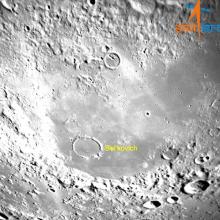Listen to today's episode of StarDate on the web the same day it airs in high-quality streaming audio without any extra ads or announcements. Choose a $8 one-month pass, or listen every day for a year for just $30.
You are here
Moon and Saturn
Saturn follows the Moon across the sky late tonight. The planet looks like a bright star, and perches close to the lower left of the Moon at first light tomorrow.
The Moon is in its “gibbous” phase now. That means that sunlight illuminates more than half of the hemisphere that faces our way.
The portion that’s in view offers a good look at the contrast between the two main landforms on the Moon: the dark “seas” and the lighter highlands.
As the name implies, the highlands are generally at a higher elevation than the seas. They’re the fractured remains of the Moon’s original crust. They consist mainly of a mineral known as anorthosite. It’s not very heavy, so when the Moon formed, it floated to the top. It contains a lot of calcium, which is why it has a lighter color.
Over the eons, impacts by space rocks blasted the crust, churning it up — like pounding the tiles on your kitchen floor with a hammer. That created a jumbled landscape of hills, mountains, canyons, and other dramatic features.
Some of the biggest impacts blasted holes all the way through the crust, or created deep cracks in the crust. That allowed molten rock to bubble up from below, forming volcanic plains. This rock, known as basalt, contains a higher concentration of dark materials, so the plains look dark. They reminded long-ago skywatchers of bodies of water, so they were called maria, the Latin word for “seas” — dark seas of rock on the surface of the Moon.
Script by Damond Benningfield





